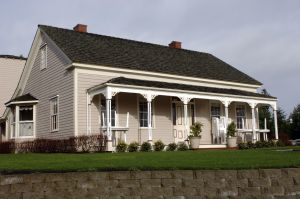There's No Place Like HomeJean Marie Thompson
Come by and walk Olympia's beautiful South Capitol Neighborhood; What does preservation of historic neighborhoods have to do with sustainability? Everything. Historic neighborhoods and buildings are terrific examples of constantly reused resources. These neighborhoods have old souls, they've been around longer than most of us, and tell us stories about our past. Their hospitality and authenticity reach out and connect us to those who have lived here long generations ago. Have you heard of social sustainability? This is the idea that the physical structures and places that embody our cultural heritage establish an essential connection between generations. Preservation of old neighborhoods can facilitate a natural, long-term relationship between people and their collective memories. Like a parade of elephants linked trunk to tail, generations feel the presence and rhythm of those before them. Our historic neighborhoods are relatively dense, hosting not only single family homes, but duplexes and apartment buildings, as well as shops, schools, churches and museums. Historic and older buildings are remarkably energy efficient because of their site sensitivity, the quality of their construction, and the use of passive heating and cooling. Construction and demolition of buildings accounts for 48% the United States' greenhouse gas emissions. One simple way to avoid these emissions is to continue to reuse, preserve, retrofit and care for the historic gems that remain. The continued use of our existing buildings reduces the amount of waste deposited in landfills, lessens reliance on new energy and building materials and conserves the energy that has already been expended to create infrastructure. Maintaining and upgrading existing neighborhoods is less costly than creating new neighborhoods. Older neighborhoods have the capacity to be yet more environmentally efficient through increased use of native plants in gardens, reliance on quality construction and recycled and green materials for remodels, and finding ways to weatherize and conserve energy. We can do all this without compromising historic character. Suchneighborhoods tend to engender a sense of community and cooperation, with porches welcoming guests, and backyard gates that seem specially designed for swapping tools and chatting with neighbors. Their scale is often intimate, making it easy to escort a stray dog home or check in on a friend. These neighborhoods offer a feeling of home for the entire community. These are all intrinsic characteristics that land use planners emulate and hope to capture when they design new neighborhoods. When historic neighborhoods or buildings are allowed to deteriorate or are demolished, a part of our past disappears forever. These places should never be taken for granted, because once we lose them, they're gone forever. When that happens, we lose touch with our history. This is a multi-faceted loss—socially, culturally, and environmentally. The historic preservation movement helps us learn to value old neighborhoods as stellar examples of sustainability and environmentalism. This brand of sustainability recognizes parts of our communities that have lasting value, and compels us to protect, preserve, and appreciate the places we have cultivated over generations as a legacy to the future. Come learn more about these connections at the Neighborhood Sustainability and Preservation Fair later this month. The event will be hosted by the South Capitol Neighborhood Association, which was awarded a Sustainability Grant from the City of Olympia to educate residents about the nexus of environmentalism, neighborhood fabric, and historic preservation. The fair will be held on September 27 from 1:00 p.m. to 5:00 p.m. at Lincoln Elementary School, 21st Avenue SE and Washington Street. Jean Marie Thomas is President of the South Capitol Neighborhood Association.
Back to Home page. |

 imagine what this part of town was like seventy-five or a hundred years ago. Now envision this old neighborhood in another one hundred years. If we try, we can maintain it for future generations. Come see sustainability in action, in a place that will offer the same sense of authenticity, aesthetics, and history to your grandchildren's children as it does to children living here today.
imagine what this part of town was like seventy-five or a hundred years ago. Now envision this old neighborhood in another one hundred years. If we try, we can maintain it for future generations. Come see sustainability in action, in a place that will offer the same sense of authenticity, aesthetics, and history to your grandchildren's children as it does to children living here today.